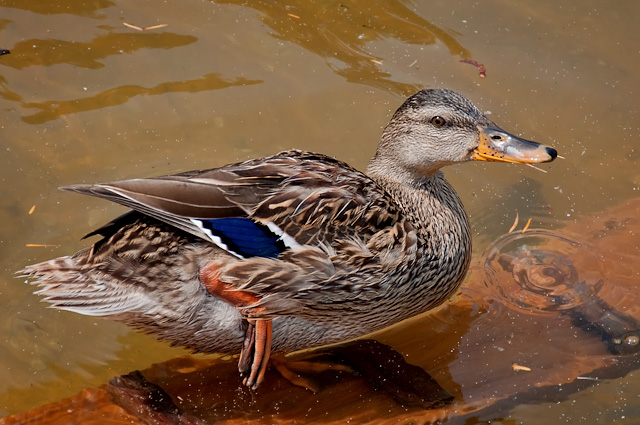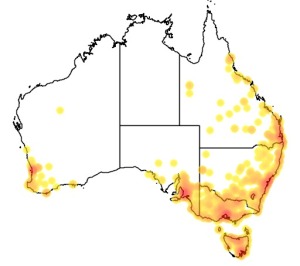Colours
Distinguishing features
The breeding male Mallard is unmistakable, with a glossy bottle-green head and white collar which demarcates the head from the purple-tinged brown breast, grey brown wings, and a pale grey belly. The rear of the male is black, with the dark tail having white borders. The bill of the male is a yellowish orange tipped with black while that of the female is generally darker ranging from black to mottled orange. The female Mallard is predominantly mottled with each individual feather showing sharp contrast from buff to very dark brown, a coloration shared by most female dabbling ducks, and has buff cheeks, eyebrow, throat and neck with a darker crown and eye-stripe. Both male and female Mallards have distinct iridescent purple blue speculum feathers edged with white, prominent in flight or at rest, though temporarily shed during the annual summer moult. Upon hatching, the plumage colouring of the duckling is yellow on the underside and face (with streaks by the eyes) and black on the backside (with some yellow spots) all the way to the top and back of the head. Its legs and bill are also black. As it nears a month in age, the duckling's plumage will start becoming drab, looking more like the female (though its plumage is more streaked) and its legs will lose their dark grey colouring. Two months after hatching, the fledgling period has ended and the duckling is now a juvenile. Between three to four months of age, the juvenile can finally begin flying as its wings are fully developed for flight (which can be confirmed by the sight of purple speculum feathers). Its bill will soon lose its dark grey colouring and its sex can finally be distinguished by three factors. The bill colouring is yellow in males, black and orange for females. The breast feathers are reddish-brown for males, brown for females. The centre tail feather is curled for males (called a drake feather), straight for females.
During the final period of maturity leading up to adulthood (6–10 months of age), the plumage of female juveniles remains the same while the plumage of male juveniles slowly changes to its characteristic colours. This plumage change also applies to adult Mallard males when they transition in and out of their non-breeding eclipse plumage at the beginning and the end of the summer moulting period. (Wikipedia)
Size
- From 52 cm to 62 cm (Length of specimen)
Wingspan
- From 81 cm to 98 cm
Synonyms
Distribution
Distribution and habitat preferences
The Mallard is widely distributed across the Northern and Southern Hemisphere, North America from southern and central Alaska to Mexico, the Hawaiian Islands, and across Eurasia, from Iceland and southern Greenland and parts of Morocco (North Africa) in the west, Scandinavia to the north, and to Siberia, Japan, and China in the east, Australia and New Zealand in the Southern hemisphere.
It is strongly migratory in the northern parts of its breeding range, and winters farther south. For example, in North America it winters south to Mexico, but also regularly strays into Central America and the Caribbean between September and May.
The Mallard inhabits a wide range of habitat and climates, from Arctic Tundra to subtropical regions. It is found in both fresh- and salt-water wetlands, including parks, small ponds, rivers, lakes and estuaries, as well as shallow inlets and open sea within sight of the coastline. Water depths of less than 1m are preferred, birds avoiding areas more than a few metres deep. They are attracted to bodies of water with aquatic vegetation. (Wikipedia)
Local abundance
- Cape Kidnappers, New Zealand: abundant
Diet
The Mallard is omnivorous and very flexible in its foods choice. Its diet may vary based on several factors, including the stage of the breeding cycle, short-term variations in available food, nutrient availability, and inter- and intraspecific competition. The majority of the Mallard's diet seems to be made up of gastropods, invertebrates (including beetles, flies, lepidopterans, dragonflies, and caddisflies), crustaceans, worms, many varieties of seeds and plant matter, and roots and tubers. (Wikipedia)
Web resources
References
- Simpson, K., N. Day and P. Trusler (2004). Field Guide to Birds of Australia: 7th Edition Penguin Group (Australia), Camberwell, Victoria.


